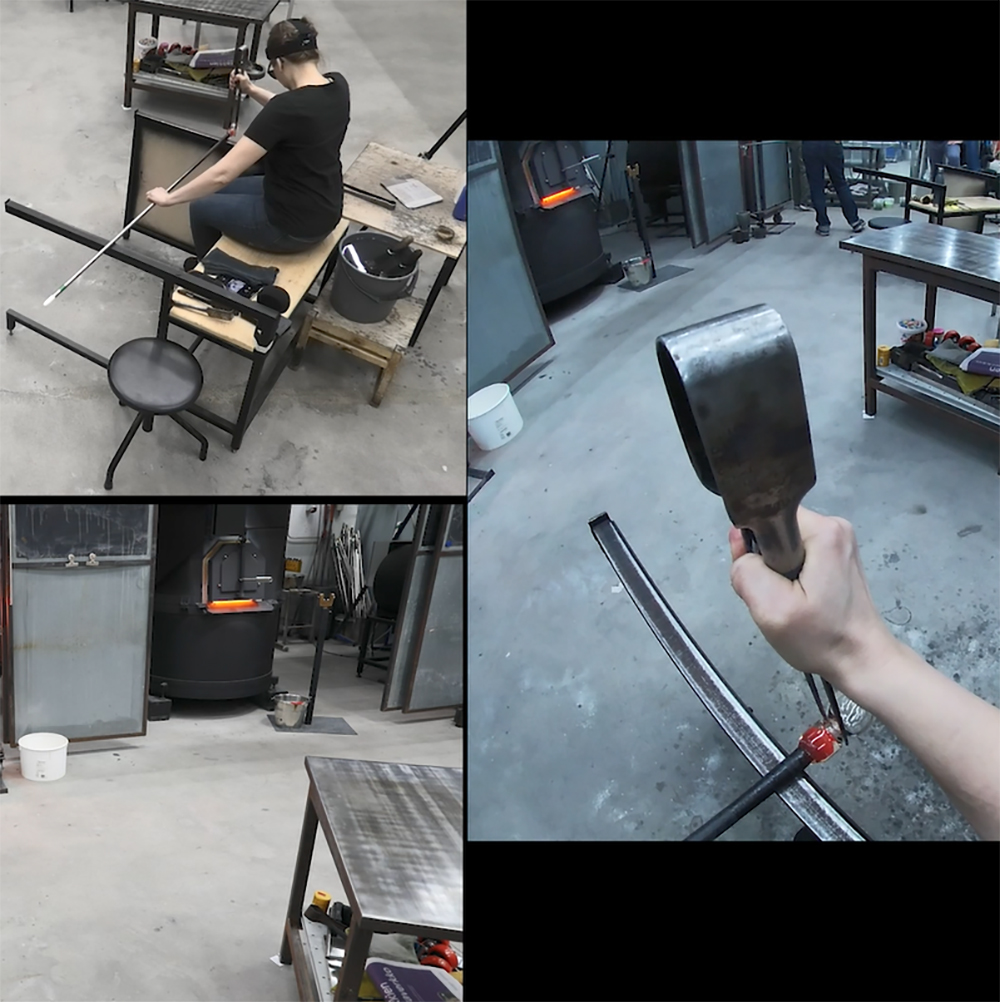Sensing the Rhythm
Analysing human and non-human movement in a glassblowing process
DOI:
https://doi.org/10.7577/formakademisk.5481Emneord (Nøkkelord):
glassblowing, movement, human and non-human, practice-led research, videoSammendrag
Glassblowing is a craft in which both human and material movement are essential. However, what kind of movement is required in glassblowing, and why does that movement happen? This article presents a practice-led case study conducted in a glassblowing studio. During a glassblowing session, clear drinking glass blanks are blown in a wooden turn mould. The process of glassblowing is documented on video and analysed using the visual data. Additionally, diary notes and participant observation are used to understand and contextualise video data more profoundly. The analysis focuses on the movement of the two main actants of the process: the human movement of the glassblower and the non-human movement of the hot glass. Altogether, six categories were identified to represent the human and material activity. This article concludes that the movement under investigation is relational between the glassblower and the hot glass, and it happens as a consequence of the glassblowers’ situated embodied knowledge. Furthermore, we discovered that research in the processes of glassblowing offers a rich ground for practice-led research that adopts relational ontology and sociomateriality as its theoretical perspectives. The purpose of this study is to fortify the craft of glassblowing as a vital practice in the fields of art, design, and craft.
Referanser
Adams, T.E., Holman, J.S. & Ellis, C. (2014). Autoethnography. Oxford University Press.
Aktas, B., & Mäkelä, M. (2019). Negotiation between the Maker and Material: Observations on Material Interactions in Felting Studio. International Journal of Design, 13(2), 55-67. http://www.ijdesign.org/index.php/IJDesign/article/view/3267/857
Flygt, E. & Falk, T. (2011). An introduction to glass: Craft, technology and art (3rd edition). Infotain & Infobook
Finnish Heritage Agency. (2021). Finland joins Unesco application related to handcrafted glass. Finnish Heritage Agency. https://www.museovirasto.fi/en/articles/finland-joins-unesco-application-related-to-handcrafted-glass [Retrieved 6 June, 2023]
Groth, C., Mäkelä, M. & Seitamaa-Hakkarainen, P. (2015). Tactile Augmentation: A multimethod for capturing experiential knowledge. Craft Research Journal, 6(1), 57–81. https://doi.org/10.1386/crre.6.1.57_1
Groth, Camilla (2017). Making Sense Through Hands. Design and Craft Practice Analysed as Embodied Cognition. (Doctoral dissertation), Aalto University, Helsinki. https://aaltodoc.aalto.fi/handle/123456789/24839
Groth, C. (2022). Video as a Tool for Knowing and Telling in Practice-led Craft Research. In Westerlund, T., Groth, C., Almevik, G. (2022). Craft Sciences. University of Gothenburg.
Koivisto, K. & Kokkonen, J. (2001). Kolme tarinaa lasista : suomalainen lasimuotoilu 1946-1957. [Three tales of glass]. [Finnish Glass Museum]. Suomen lasimuseo.
Koivisto, K. & Laurén, U. (2013). Suomalaisen taidelasin kultakausi. [The golden era of the Finnish glass]. Tammi.
Klein, D. & Lloyd, W. (1984). The history of glass. London Orbis
Lightfoot, C. S., Buljević Zrinka, Israeli, Y., Wight, K., Wypyski, M. T., Ennion, E., & Metropolitan Museum of Art (New York, N.Y.). (2015). Ennion : Master of roman glass. Metropolitan Museum of Art, New York.
Metsänkylä, A. & Suutari, P. (1992). Työryhmä: verstakko: Raportti lasinpuhalluksesta Nuutajärven lasitehtaalla. [Chair, a glassmaking team]. [National Board of Antiquities. Workers Culture Publications]. Helsinki: Museovirasto.
Mäkelä, M., & Nimkulrat, N. (2011). Reflection and documentation in practice-led design research. In I. Koskinen, T. Härkäsalmi, B. Matthews, & J-J. Lee (Eds.), Proceeding of The 4th Nordic Design Research Conference ‘MAKING DESIGN MATTER! (pp. 120–128). NORDES.
Mäkelä, & Routarinne, S. (2006). The art of research: Research practices in art and design. University of Art and Design Helsinki.
Nurmi, Sammallahti, L., Hilpinen, L., Valle, E., & Salenius, H. (1989). Lasinvalmistajat ja lasinvalmistus Suomessa 1900-luvun alkupuolella. [Glassworkers and manufacturing in Finland, 1900–1930]. Suomen muinaismuistoyhdistys.
O’Connor, E. (2009). Hotshop: An ethnography of embodied knowledge in glassblowing.
O’Connor, E. & Peck, S. (2016). The Prototype: Problem Work in the Relationship between Designer, Artis, and Gaffer in Glassblowing. In Marchand, T.H.J; (ed.). (2016). Craftwork as Problem Solving: Ethnographic Studies of Design and Making (pp. 33–49). Ashgate Publishing Limited.
Polanyi, & Sen, A. (2009). The tacit dimension. University of Chicago Press.
Schön. (1983). The reflective practitioner: how professionals think in action. Basic Books.
Sennett, R. (2008). The craftsman. Yale University Press.
Spradley, J.P. (1980). Participant observation. Holt, Rinehart and Winston.
Vega, L. (2021) Distributed thinking through making: Towards a relational ontology in practice-led design research. In E. Brandt, T. Markussen, E. Berglund, G, Julier & P. Linde (eds.), Nordes 2021: Matters of Scale, 15-18 August, Kolding, Denmark. NORDES. https://doi.org/10.21606/nordes.2021.29
Westerlund T., Groth, C., & Almevik, G. (2022). Craft sciences. University of Gothenburg.

Nedlastinger
Publisert
Hvordan referere
Utgave
Seksjon
Lisens
Opphavsrett 2023 Sara Hulkkonen, Miia Lötjönen, Maarit Mäkelä

Dette verket er lisensiert under Creative Commons Attribution-NoDerivatives 4.0 International License.
- Forfatteren(e) beholder sin opphavs- og kopieringsrett til eget manuskript, men gir tidsskriftet varig rett til 1) å fremføre manuskriptet for offentligheten i den opprinnelig publiserte digitale form, og 2) å registreres og siteres som første publisering av manuskriptet.
- Forfatteren må selv forvalte sine økonomiske kopieringsrettigheter overfor eventuell tredjepart.
- Tidsskriftet gir ingen økonomisk eller annen kompensasjon for innsendte bidrag, medmindre det er gjort særskilt avtale om dette med forfatteren(e).
- Tidsskriftet plikter å arkivere manuskriptet (inklusive metadata) i den opprinnelig publiserte digitale form, i minst ett dertil egnet åpent tilgjengelig langtidsarkiv for digitalt materiell, som for eksempel i de norske universitetenes institusjonsarkiv innen rammen av NORA-samarbeidet.
Verket vil bli publisert OpenAccess med en Creative Commons 4.0-lisens som tillater alle å lese, dele og tilpasse innholdet, også kommersielt, under lisensvilkårene:
Dette verket må tilskrives/ krediteres på riktig måte, en lenke må gis til CC-BY 4.0-lisensen, og endringer som er gjort må angis på en rimelig måte, men ikke på noen måte som antyder at lisensgiveren støtter deg eller din bruk.



